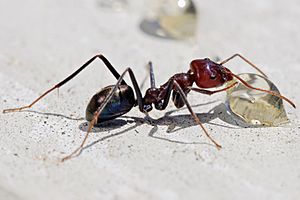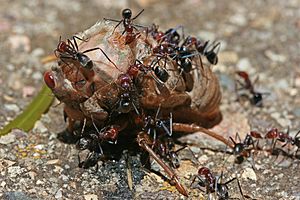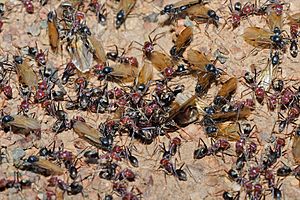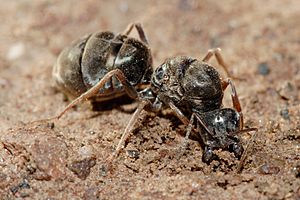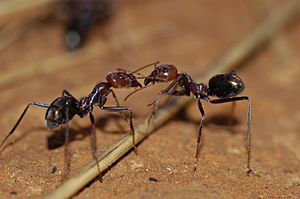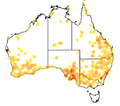Meat ant facts for kids
Quick facts for kids Meat ant |
|
|---|---|
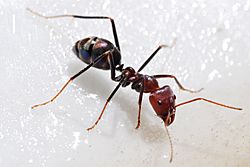 |
|
| Meat ant | |
| Conservation status | |
|
Not evaluated (IUCN 3.1)
|
|
| Scientific classification | |
| Kingdom: | |
| Phylum: | |
| Class: | |
| Order: | |
| Family: | |
| Subfamily: |
Dolichoderinae
|
| Tribe: |
Leptomyrmecini
|
| Genus: | |
| Species: |
I. purpureus
|
| Binomial name | |
| Iridomyrmex purpureus (Smith, 1858)
|
|
| Synonyms | |
|
|
Meat ants (Iridomyrmex purpureus), also known as meat-eater ants or gravel ants, are a species of ant belonging to the Iridomyrmex genus. They can be found throughout Australia.
Contents
Etymology
The specific epithet of the meat ant, purpureus, derives from Latin, meaning "purple", "purple-coloured" or "dark-red", referencing the coloured appearance of the ant. In classical Latin, purpureus primarily translated to "dyed purple", while the word purpura, originally used as the specific name for the meat ant (Formica purpura), translates to "purpled-dyed cloth". The name of the genus of the meat ant, Iridomyrmex, translates to "rainbow ants", another reference which points to its appearance; this in particular is due to its blue-green iridescence colour. The word Irido, meaning "rainbow", derives from Ancient Greek, and myrmex, another Greek word, means "ant".
Behaviour and ecology
Foraging
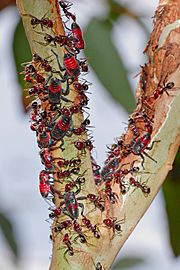
The meat ant is a diurnal species and there is little overlap when they and nocturnal ants are active at the same location. The meat ant and other members of the genus Iridomyrmex are regarded as a dominant group of diurnal species in Australia, as they are highly active, aggressive and their distribution is nationwide. During the day, workers will attend and feed from secreting insects who give them honeydew which live on Eucalyptus trees. Meat ants will create foraging trails, a trail which is easily visible due to the absence of vegetation, and ants will forage on these to trees they favour most. This is important for food sources and water, especially when days are hot and dry. While trails are known to lead to trees, others will lead to other nests which are known as satellite nests; nests that belong to the same colony, but they are not technically the main nest. Other workers in smaller numbers will often scavenge around for dead insects or other foods to bring back to their colony. Nests will not regularly occur in shaded areas; this allows the nest to get warm when exposed to the sun, The rate of movement of workers and temperature is associated with each other, and foraging workers leave the nest after sunrise when the nest is warmed in the early morning.
Diet
Like other Iridomyrmex species, the meat ant is an omnivore, retrieving food sources from various insects they tend including caterpillars and various sorts of butterflies, particularly the larvae of the Waterhouse's Hairstreak (Jalmenus lithochroa). These ants prey on various insects and animals; they will prey on Crucifix toads while they go through metamorphism, and take the eggs and larvae from Trichogramma wasps. Giant lacewings of the genus Ithone are preyed on by meat ants, where they will swarm up on trees to attack them, while Ogyris genoveva butterflies are preyed upon. Other insects the meat ant preys on include the Indian mealmoth, Almond moth and the Western Australian Jarrah Leafminer. On sandy beaches, this species is observed preying on the Polychaete annelid worm, Armandia intermedia, causing high mortality rates on them (rates of 30 percent). While meat ants usually feed on honeydew, flower nectar and other sweet substances, these ants will feed on dead snakes, lizards, birds and other insects. On some occasions, meat ants have been found around dead foxes. The meat ant is the only known ant in Australia that feeds on guano.
Predators
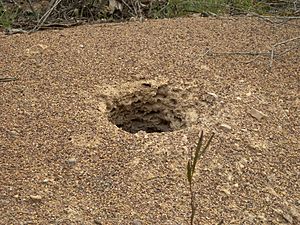
While the meat ant is a dominant species of ant in Australia, a number of animals are known to prey on them. The Short-beaked echidna (Tachyglossus aculeatus) is a prominent predator of the meat ant, mostly due to the virgin queen ants present containing high levels of fat. These queens can almost contain 47% fat, and so when no queens are available after an attack, an echidna may stop attacking the nest. However, these ants are normally consumed either in low numbers or avoided entirely. Attacking echidnas would burrow down in the hole they have made and consume them (mostly for the queens) while handling the bites from the ants, as they frequently scratch themselves on the head and chest. The echidna does not consume meat ants throughout the whole year; Instead, echidnas in Canberra would only attack meat ant nests from August to October, which is when nuptial flight usually occurs. This particular time period makes it much easier for echidnas to prey on the winged females since they are directly above on the nest.
Several birds prey on meat ants. The Masked woodswallow (Artamus personatus) and the White-browed woodswallow (Artamus superciliosus) will gather around on their nests and swoop them, catching several ants before eating them. Pieces of meat ants have been found in the Red-capped robin (Petroica goodenovii), Rufous whistler (Pachycephala rufiventris), Hooded robin (Melanodryas cucullata) and the Red-browed treecreeper (Climacteris erythrops). Meat ants who foraged on Ventilago viminalis trees were often eaten by the Apostlebird. Some large ground-feeding birds, such as Currawongs, Magpies and Ravens will dig out newly established colonies after a queen has found a suitable spot to nest. Since small domes of excavated soil is present, this will reveal their presence to these birds. Due to this, many queens will be eaten by these birds, leaving many abandoned nest chambers.
The blind snake Ramphotyphlops nigrescens follow trails laid by meat ants to possibly to locate them as a potential prey species, and they are also known to eat on the brood of this species. Various species of spiders prefer to prey on meat ants, which are mainly attracted by the alarm pheromone the ants release. One spider in particular, the cursorial spider Habronestes bradleyi, is a specialist predator against these ants and will use their alarm pheromones that is released during territorial disputes to locate them.
Moths of the genus Cyclotorna, particulartly Cyclotorna monocentra feeds on meat ant brood. The larvae of these moths are parasites to leaf-hoppers, and will move to meat ant colonies to complete their development, where they will proceed to consume the brood. Females will lay many eggs near ant trails which are close to the leaf-hoppers which the ants attend to. Other observations show that the larvae of the moth species Iphierga macarista is a scavenger in meat ant nests, while Sphallomorpha beetles live in burrows near nests of meat ants, and the larvae of this genus can be found in nests which capture and prey on workers passing by. The larvae of the Spitfire sawfly and Pseudoperga guerini are able to regurgitate a fluid against the meat ant if they are getting attacked by them; depending on how much is regurgitated, an ant will either walk away and clean itself, or become fatally affected by it. Lizards such as the Thorny dragon, a sit and wait predator that consumes meat ants, but other lizards which eat Iridomyrmex ants usually reject this species.
Life cycle and reproduction
Nuptial flight usually occurs during spring in October. Reproductive new queen ants will only mate with a single male alate and begin establishing her own colony. Nuptial flight occurs after rain, where the males would emerge from their nest first, followed by the virgin queens. Groups of 20 to 40 females occur after the males have flown away. They would position themselves on top of the nest in order to heat themselves, and would all fly at the same time once they are warm. This process would happen multiple times unless the weather had changed, otherwise the queens would return to their nest. Nuptial flight would continue for days until all virgin queens have withdrawn from the nest. Most of the time, a single queen will start her own colony and lay eggs that will take around 44 to 61 days to fully develop and emerge as adults, but can also be founded through multiple queens cooperating with each other, adoption into an existing colony, or "budding" (also called "satelliting" or "fractionating"), where a subset of the colony including queens, workers and brood (eggs, larvae and pupae) leave the main colony for an alternative nest site. Around 10% of queens will have at least another queen with them during colony foundation. Many queens are killed during colony founding; major aspects include predation by birds and other ants, even those of the same species, due to the fact they attempt to establish their nests near large colonies. However, some queens are successful with this, and sometimes they would even be attended and protected by neighbouring workers, and would also help the queen dig some chambers. Other indications of queen deaths include disease and starvation. A queens ovaries may take four weeks to mature, and she will lay around 20 eggs that may develop into larvae in less than a month. Workers have been observed laying eggs, presumably trophic eggs.
A mature nest of several years of age can hold up to 11,000 - 64,000 ants, while other estimates are around 300,000. During this time, some nests are known to contain nearly 70,000 larvae, 64,000 workers, 20,000 males and over 1,000 virgin queens. However, some colonies contain more virgin queens than males. The ratio of worker ants and number of larvae in colonies ranges from one for every two, or two for every one.
Most colonies are monogyne, where a colony will only have a single queen, but based on observations, nests can contain more than a single queen. Some nests are known to contain two queens, with some even having as many as four in a single colony. Some colonies are oligogynous, which means that multiple queens are present in a colony, but they are tolerated by all workers birthed from different queens, and were also treated equally. Tolerance still occurred even when new reproductive females and males are born, but recognition based on kin from queens and workers is known, hinting brood discrimination when larvae are fed or groomed; queens would only take care of their own brood and neglect to look after brood laid by other queens. The queens on the other hand will only cooperate with each other during nest founding, but will be antagonistic once there are workers present in the colony. Queens will become more intolerant to each other as the colony grows, and eventually separate within the nest, resulting in the queen laying more eggs. Such cases usually happen when pleometrotic founding occurs, or if a queen ant is adopted by a colony, setting up aggressive relationships. Physical fights between queens in the same colony is rare. The Meat ant is a polydomous species, meaning that they live in more than one nest. Workers of the same colony who live in different nests tend to be aggressive to each other.
Ritualised fighting
Meat ants are highly territorial and aggressive ants which establish firm borders around neighbouring colonies. While the boundaries are not physical, worker ants maintain this by engaging in ritualised fighting with opponent ants, an interaction most colonies engage in. Fatalities are rare on both sides but sometimes it may cause an occasional injury to several workers. The meat ant has evolved over time where it will mainly engage in ritualised fighting to resolve territorial disputes with nearby or neighbouring colonies, as this enables territory to be contested between opposing colonies without them killing each other, costing many casualties on both sides. Because of this, it is a method of avoiding casualties and promotes intercolony communication and assessment. A drainage of the work force would occur if these boundaries acted as a conflict zone if ritualised fighting does not take place. Lethal fighting will occur if the colony is under attack.
An encounter between workers lasts for 15 seconds. Ritualised fight only occurs with two worker ants who come into contact with each other, but this will break if both ants are from the same colony, followed by them grooming themselves. After, they would later walk around until they make contact with another ant. A meat ant detects a foreign worker by intense antennation and gaping of the mandibles, and will also stretch themselves upward to appear taller and larger, suggesting that meat ants will do this in a display of size-matching. Workers will perform a behaviour known as "front leg boxing"; both workers will have their front legs sweeping up and down, where it would flex at the coxal joint in a paddling motion. This paddling motion was both aimed at each other during this behaviour, going on for three to five seconds on average. From this point on, this would determine who is a "loser" and who is the "winner".
The ant who lost the ritual fight will lower its body, where it would lean sideways from the victorious ant. The victorious ant will remain raised upward and would reach down to the worker and open its mandibles wider, where it would grasp on the ants mandibles, and then tugs and shakes its head slightly for a brief moment of time. However, ritual fights may continue if neither worker backs down, and would commence a side to side posture. They would raise their bodies and circle each other and present their gasters directed to their opponent, and on some occasions, either one or both of the ants would kick outward using their legs at each other. Eventually, they will break contact and groom once appeasement has been reached and continue to search for another ant.
Relationship with other organisms and humans
Meat ants have been observed blocking banded sugar ant nesting holes with pebbles and soil to prevent them from leaving their nest during the early hours of the day. The ants counter this by preventing meat ants from leaving their nest by blocking their nesting holes with debris, a behaviour known as nest-plugging. If meat ant nests are encroached by trees or other shade, banded sugar ants may invade and take over the nest, since the health of the colony may deteriorate from overshadowing. Members of an affected meat ant colony later move to a nearby satellite nest that is placed in a suitable area, while invading banded sugar ants fill nest galleries up with a black resinous material.
Meat ants are generally intolerant of myrmecophiles living in their colonies, but Cyclotorna larvae and carabid beetles in the genus Spallomorpha have been known to dwell in colonies. Unused or abandoned areas inside colonies are sometimes occupied by other species of ants and in some cases, termites. Meat ants are able to kill poisonous cane toads, an introduced pest, as the toxins that usually kill cane toad's predators do not affect the meat ants. The cane toad's normal response to attack is to stand still and let their toxin kill the attacker, which allows the immune ant to easily attack and eat the toad.
In rural Australia, meat ants are important to farmers as they place animal carcasses on their nests. In a matter of weeks, the entire carcass will be consumed and reduced to bones. However, meat ants are sometimes considered pests, due to these ants entering human houses to feed on food and soil disturbance. The nests may cause annoyance if nests are formed around gravel paths, tennis courts and other cleared spaces. Eradication of nests can be difficult, as nests can be repopulated from a rival colony or adjoining nests which were not affected. Particular species have adapted rather well to urbanisation; during the early days in Canberra, newly constructed suburbs provided new nest sites for meat ants, and populations flourished. Other factors include plantations enriched with valuable food sources and home gardens.
Images for kids
-
Meat ant mound near Bungendore, New South Wales
-
Worker with a common jassid nymph. These insects excrete a sugary sap that is collected by the ants, which protect this valuable food resource.
See also
 In Spanish: Hormiga de la carne para niños
In Spanish: Hormiga de la carne para niños


